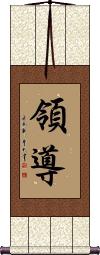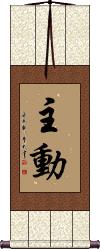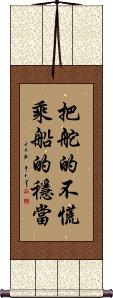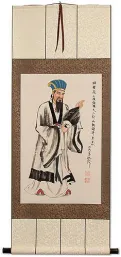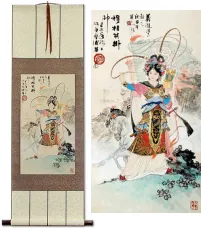Many custom options...
And formats...

Leadership in Chinese / Japanese...
Buy a Leadership calligraphy wall scroll here!
Personalize your custom “Leadership” project by clicking the button next to your favorite “Leadership” title below...
1. Leadership
3. Leadership / Ability to Lead
4. The Confident Helmsman Inspires Confidence in the Passengers
Leadership
領導 is the Chinese word for “Leadership.”
It contains the ideas of “to lead,” “to direct,” “to conduct,” and “to guide.” Putting a wall scroll with this word on your wall suggests that you are honing your leadership skills or holding a leadership position.
Initiative / Leadership
In Chinese, this word means “to take the initiative.”
In Japanese and Korean, the meaning varies slightly to meaning that leans more toward “leadership” (as in one who is leading a group or organization).
Leadership / Ability to Lead
指導力 is the Japanese word for “Leadership.”
This refers to the ability to lead (or, with certain adjectives added, the lack of ability to lead).
The Confident Helmsman Inspires Confidence in the Passengers
把舵的不慌乘船的稳当 is a Chinese proverb that literally translates as: [If the] helmsman is not nervous, the passengers [will feel] secure.
Figuratively, this means: If the leader appears confident, his/her followers will gain confidence also.
This is a great suggestion that a confident leader inspires confidence in his/her troops or followers. Of course, a nervous leader will create fear in troops or followers.
Hou De Zai Wu
Art of War: 5 Points of Analysis
道天地將法 is a list of five key points to analyzing your situation from the first chapter of Sun Tzu's Art of War.
This reads like a 5-part military proverb. Sun Tzu says that to sharpen your skills, you must plan. To plan well, you must know your situation. Therefore, you must consider and discuss the following:
1. Philosophy and Politics: Make sure your way or your policy is agreeable among all of your troops (and the citizens of your kingdom as well). For when your soldiers believe in you and your way, they will follow you to their deaths without hesitation and will not question your orders.
2. Heaven/Sky: Consider climate / weather. This can also mean considering whether God is smiling upon you. In the modern military, this could be waiting for clear skies so that you can have air support for an amphibious landing.
3. Ground/Earth: Consider the terrain in which the battle will take place. This includes analyzing defensible positions, and exit routes, while using varying elevations to your advantage. When you plan an ambush, you must know your terrain and the best location from which to stage that ambush. This knowledge will also help you avoid being ambushed, as you will know where the likely places in which to expect an ambush from your enemy.
4. Leadership: This applies to you as the general and your lieutenants. A leader should be smart and be able to develop good strategies. Leaders should keep their word, and if they break a promise, they should punish themselves as harshly as they would punish subordinates. Leaders should be benevolent to their troops, with almost a fatherly love for them. Leaders must have the ability to make brave and fast decisions. Leaders must have steadfast principles.
5. [Military] Methods: This can also mean laws, rules, principles, models, or systems. You must have an efficient organization in place to manage both your troops and supplies. In the modern military, this would be a combination of how your unit is organized and your SOP (Standard Operating Procedure).
Notes: This is a simplistic translation and explanation. Much more is suggested in the actual text of the Art of War (Bing Fa). It would take a lot of study to master all of these aspects. In fact, these five characters can be compared to the modern military acronyms such as BAMCIS or SMEAC.
CJK notes: I have included the Japanese and Korean pronunciations but in Chinese, Korean and Japanese, this does not make a typical phrase (with subject, verb, and object) it is a list that only someone familiar with Sun Tzu’s writings would understand.
This in-stock artwork might be what you are looking for, and ships right away...
Gallery Price: $71.00
Your Price: $39.00
Gallery Price: $108.00
Your Price: $59.88
Not the results for leadership that you were looking for?
Below are some entries from our dictionary that may match your leadership search...
| Characters If shown, 2nd row is Simp. Chinese |
Pronunciation Romanization |
Simple Dictionary Definition |
主動 主动 see styles |
zhǔ dòng zhu3 dong4 chu tung shudou / shudo しゅどう |
More info & calligraphy: Initiative / Leadershipleadership |
菩薩 菩萨 see styles |
pú sà pu2 sa4 p`u sa pu sa mizoro みぞろ |
More info & calligraphy: Bodhisattva(n,n-suf) (1) {Buddh} bodhisattva; one who has reached enlightenment but vows to save all beings before becoming a buddha; (n,n-suf) (2) High Monk (title bestowed by the imperial court); (n,n-suf) (3) (See 本地垂迹説) title bestowed to Shinto kami in manifestation theory; (surname) Mizoro bodhisattva, cf. 菩提薩埵. While the idea is not foreign to Hīnayāna, its extension of meaning is one of the chief marks of Mahāyāna. 'The Bodhisattva is indeed the characteristic feature of the Mahāyāna.' Keith. According to Mahāyāna the Hinayanists, i.e. the śrāvaka and pratyekabuddha, seek their own salvation, while the bodhisattva's aim is the salvation of others and of all. The earlier intp. of bodhisattva was 大道心衆生 all beings with mind for the truth; later it became 大覺有情 conscious beings of or for the great intelligence, or enlightenment. It is also intp. in terms of leadership, heroism, etc. In general it is a Mahayanist seeking Buddhahood, but seeking it altruistically; whether monk or layman, he seeks enlightenment to enlighten others, and he will sacrifice himself to save others; he is devoid of egoism and devoted to helping others. All conscious beings having the Buddha-nature are natural bodhisattvas, but require to undergo development. The mahāsattva is sufficiently advanced to become a Buddha and enter nirvāṇa, but according to his vow he remains in the realm of incarnation to save all conscious beings. A monk should enter on the arduous course of discipline which leads to Bodhisattvahood and Buddhahood. |
領導 领导 see styles |
lǐng dǎo ling3 dao3 ling tao ryoudou / ryodo りょうどう |
More info & calligraphy: Leadership(noun/participle) leadership; guidance |
指導力 see styles |
shidouryoku / shidoryoku しどうりょく |
More info & calligraphy: Leadership / Ability to Lead |
覇 霸 see styles |
bà ba4 pa haru はる |
variant of 霸[ba4] (1) (See 覇を唱える) supremacy (over a nation); hegemony; domination; leadership; (2) championship; victory; (female given name) Haru |
主導 主导 see styles |
zhǔ dǎo zhu3 dao3 chu tao shudou / shudo しゅどう |
leading; dominant; prevailing; to lead; to direct; to dominate (noun, transitive verb) leadership; initiative; spearhead |
先導 先导 see styles |
xiān dǎo xian1 dao3 hsien tao sendou / sendo せんどう |
to lead the way; guide; forerunner; pioneer (noun, transitive verb) guidance; leadership; leading the way guide |
兵權 兵权 see styles |
bīng quán bing1 quan2 ping ch`üan ping chüan |
military leadership; military power |
在位 see styles |
zài wèi zai4 wei4 tsai wei zaii / zai ざいい |
to be on the throne; to reign; to hold a particular leadership position (n,vs,vi) reign; being on the throne |
小乘 see styles |
xiǎo shèng xiao3 sheng4 hsiao sheng shōjō |
Hinayana, the Lesser Vehicle; Buddhism in India before the Mayahana sutras; also pr. [Xiao3 cheng2] Hīnayāna 希那衍. The small, or inferior wain, or vehicle; the form of Buddhism which developed after Śākyamuni's death to about the beginning of the Christian era, when Mahāyāna doctrines were introduced. It is the orthodox school and more in direct line with the Buddhist succession than Mahāyānism which developed on lines fundamentally different. The Buddha was a spiritual doctor, less interested in philosophy than in the remedy for human misery and perpetual transmigration. He "turned aside from idle metaphysical speculations; if he held views on such topics, he deemed them valueless for the purposes of salvation, which was his goal" (Keith). Metaphysical speculations arose after his death, and naturally developed into a variety of Hīnayāna schools before and after the separation of a distinct school of Mahāyāna. Hīnayāna remains the form in Ceylon, Burma, and Siam, hence is known as Southern Buddhism in contrast with Northern Buddhism or Mahāyāna, the form chiefly prevalent from Nepal to Japan. Another rough division is that of Pali and Sanskrit, Pali being the general literary language of the surviving form of Hīnayāna, Sanskrit of Mahāyāna. The term Hīnayāna is of Mahāyānist origination to emphasize the universalism and altruism of Mahāyāna over the narrower personal salvation of its rival. According to Mahāyāna teaching its own aim is universal Buddhahood, which means the utmost development of wisdom and the perfect transformation of all the living in the future state; it declares that Hīnayāna, aiming at arhatship and pratyekabuddhahood, seeks the destruction of body and mind and extinction in nirvāṇa. For arhatship the 四諦Four Noble Truths are the foundation teaching, for pratyekabuddhahood the 十二因緣 twelve-nidānas, and these two are therefore sometimes styled the two vehicles 二乘. Tiantai sometimes calls them the (Hīnayāna) Tripiṭaka school. Three of the eighteen Hīnayāna schools were transported to China: 倶舍 (Abhidharma) Kośa; 成實 Satya-siddhi; and the school of Harivarman, the律 Vinaya school. These are described by Mahāyānists as the Buddha's adaptable way of meeting the questions and capacity of his hearers, though his own mind is spoken of as always being in the absolute Mahāyāna all-embracing realm. Such is the Mahāyāna view of Hīnayāna, and if the Vaipulya sūtras and special scriptures of their school, which are repudiated by Hīnayāna, are apocryphal, of which there seems no doubt, then Mahāyāna in condemning Hīnayāna must find other support for its claim to orthodoxy. The sūtras on which it chiefly relies, as regards the Buddha, have no authenticity; while those of Hīnayāna cannot be accepted as his veritable teaching in the absence of fundamental research. Hīnayāna is said to have first been divided into minority and majority sections immediately after the death of Śākyamuni, when the sthāvira, or older disciples, remained in what is spoken of as "the cave", some place at Rājagṛha, to settle the future of the order, and the general body of disciples remained outside; these two are the first 上坐部 and 大衆部 q. v. The first doctrinal division is reported to have taken place under the leadership of the monk 大天 Mahādeva (q.v.) a hundred years after the Buddha's nirvāṇa and during the reign of Aśoka; his reign, however, has been placed later than this by historians. Mahādeva's sect became the Mahāsāṅghikā, the other the Sthāvira. In time the two are said to have divided into eighteen, which with the two originals are the so-called "twenty sects" of Hīnayāna. Another division of four sects, referred to by Yijing, is that of the 大衆部 (Arya) Mahāsaṅghanikāya, 上座部 Āryasthavirāḥ, 根本說一切有部 Mūlasarvāstivādaḥ, and 正量部 Saṃmatīyāḥ. There is still another division of five sects, 五部律. For the eighteen Hīnayāna sects see 小乘十八部. |
幹部 干部 see styles |
gàn bù gan4 bu4 kan pu kanbu かんぶ |
cadre; official; officer; manager management; (executive) staff; leaders; leadership; top brass; upper echelons |
指導 指导 see styles |
zhǐ dǎo zhi3 dao3 chih tao shidou / shido しどう |
to guide; to direct; to instruct; coach; trainer (noun, transitive verb) (1) guidance; leadership; instruction; direction; coaching; (2) {MA} shido (minor penalty in judo) |
接班 see styles |
jiē bān jie1 ban1 chieh pan |
to take over (from those working the previous shift); to take over (in a leadership role etc); to succeed sb |
法將 法将 see styles |
fǎ jiàng fa3 jiang4 fa chiang hōshō |
Dharma-generals, i.e. monks of high character and leadership. |
篡黨 篡党 see styles |
cuàn dǎng cuan4 dang3 ts`uan tang tsuan tang |
to usurp the leadership of the party |
統率 统率 see styles |
tǒng shuài tong3 shuai4 t`ung shuai tung shuai tousotsu / tosotsu とうそつ |
to command; to direct (noun, transitive verb) command; lead; generalship; leadership |
裸退 see styles |
luǒ tuì luo3 tui4 lo t`ui lo tui |
(neologism c. 2007) (of an official) to retire completely from all leadership positions |
黨組 党组 see styles |
dǎng zǔ dang3 zu3 tang tsu |
party leadership group |
主導性 主导性 see styles |
zhǔ dǎo xìng zhu3 dao3 xing4 chu tao hsing |
leadership |
主導権 see styles |
shudouken / shudoken しゅどうけん |
hegemony; leadership; initiative |
主導權 主导权 see styles |
zhǔ dǎo quán zhu3 dao3 quan2 chu tao ch`üan chu tao chüan |
leadership (role) |
代表選 see styles |
daihyousen / daihyosen だいひょうせん |
leadership election |
先導性 see styles |
sendousei / sendose せんどうせい |
leadership |
党幹部 see styles |
toukanbu / tokanbu とうかんぶ |
leading members of a party; party executive; party leadership; senior party members |
執行部 see styles |
shikkoubu / shikkobu しっこうぶ |
(the) executive; administration; leadership |
惣領制 see styles |
souryousei / soryose そうりょうせい |
sōryō system; organization of regional landholding families based on divided inheritance under the leadership of a main heir, usu. the eldest son (Kamakura period) |
指導部 see styles |
shidoubu / shidobu しどうぶ |
leadership |
楫取り see styles |
kajitori かじとり |
(out-dated kanji) (noun/participle) (1) steering; helmsman; coxswain; (2) guidance; leadership; leader |
統率力 see styles |
tousotsuryoku / tosotsuryoku とうそつりょく |
leadership; generalship |
舵取り see styles |
kajitori かじとり |
(noun/participle) (1) steering; helmsman; coxswain; (2) guidance; leadership; leader |
Click here for more leadership results from our dictionary
The following table may be helpful for those studying Chinese or Japanese...
| Title | Characters | Romaji (Romanized Japanese) | Various forms of Romanized Chinese | |
| Leadership | 領導 领导 | lǐng dǎo / ling3 dao3 / ling dao / lingdao | ling tao / lingtao | |
| Initiative Leadership | 主動 主动 | shudou / shudo | jī jí / ji1 ji2 / ji ji / jiji | chi chi / chichi |
| Leadership Ability to Lead | 指導力 指导力 | shidouryoku shidoryoku | ||
| The Confident Helmsman Inspires Confidence in the Passengers | 把舵的不慌乘船的穩當 把舵的不慌乘船的稳当 | bǎ tuò de bù huāng chéng chuán de wěn dang ba3 tuo4 de bu4 huang1 cheng2 chuan2 de wen3 dang ba tuo de bu huang cheng chuan de wen dang | pa t`o te pu huang ch`eng ch`uan te wen tang pa to te pu huang cheng chuan te wen tang |
|
| Hou De Zai Wu | 厚德載物 厚德载物 | hòu dé zài wù hou4 de2 zai4 wu4 hou de zai wu houdezaiwu | hou te tsai wu houtetsaiwu |
|
| Art of War: 5 Points of Analysis | 道天地將法 道天地将法 | dou ten chi shou hou doutenchishouhou do ten chi sho ho | dào tiān dì jiàng fǎ dao4 tian1 di4 jiang4 fa3 dao tian di jiang fa daotiandijiangfa | tao t`ien ti chiang fa taotientichiangfa tao tien ti chiang fa |
| In some entries above you will see that characters have different versions above and below a line. In these cases, the characters above the line are Traditional Chinese, while the ones below are Simplified Chinese. | ||||
Successful Chinese Character and Japanese Kanji calligraphy searches within the last few hours...
